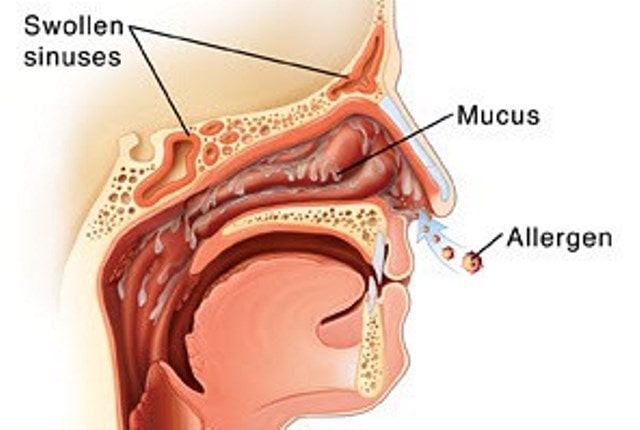It is possible for simple nose stuffiness to develop into chronic stuffy nose. To help prevent this, it is important to learn what it means to have a nose that is stuffy. This will help prevent it from deteriorating. Of even greater importance is knowing what causes a stuffy nose. Read on to learn this and more.
What is a Stuffy Nose, Meaning

A stuffy nose, also referred to as nasal congestion, blocked nose, clogged nose or nasal obstruction is “the blockage of the nasal passages due to membranes lining the nose becoming swollen from inflamed blood vessels.” [Wikipedia.org]
What Causes a Stuffy Nose
The irritation and discomfort that comes with it could leave one wondering what causes a stuffy nose so they can learn how to deal with or avoid it. There are a number of specific causes. Medical practitioners have however categorized them into for broad causes. These are allergic, structural abnormalities, infections and non-allergic rhinitis. We discuss these in details below.
What Causes a Stuffy Nose #1– Structural Abnormalities
The nasal septum is the bone and thin cartilage which divides the two sides of the nostrils. A nose that is stuffy could be caused by deformities in the nose and nasal septum. The deformities are mostly caused by nasal injuries some being experienced as early as during the birth process. Research shows that seven percent newborns suffer nasal injury during the birth process.
The injuries are common children as well as in adults. Where they cause obstruction to breathing, surgical correction may help ease the problem.
Some specific examples of structural abnormalities are when children suffer from enlarged adenoids. Adenoids are tonsil-like tissues which are located at the back of the nose. When they become enlarged, breathing becomes noisy especially at night. Snoring may also be heard. If the problem is severe, children may result to being mouth breathers. This will result to dental deformities or even a sagging face. To correct this, surgery may be necessary to remove the adenoids.
Other structural abnormalities include the presence of foreign bodies in the nasal cavity. When children are playing unsupervised, they tend to insert objects into their noses. Nasal tumors too may interfere with the functioning of the nasal cavity. If any abnormal and smelly discharge is seen draining from the nose, these could be some of the causes. Consulting a physician will help nail the cause.
What Causes a Stuffy Nose #2- Vasomotor Rhinitis
This refers to an inflammation of the nasal membranes which have a number of blood vessels and nerves. The membranes have a dense network of capillaries, veins and arteries. These have the ability to constrict and expand. When one engages in vigorous activities there is a rise in adrenaline. This tends to constrict the nasal membranes causing the passages to open up so that the person can breathe with ease.
When a person suffers a cold or develops allergic attacks, the vessels expand. This congests the membranes thus blocking the nose. It feels stuffy.

Other circumstances that may cause an expansion of the blood vessels thus lead to vasomotor rhinitis include drugs to cub high blood pressure, pregnancy, psychological stress, exposure to smoke and perfumes.
Nasal stuffiness is usually temporary and can be reversed in the early stages. If the condition is experienced for long, the blood vessels lose their ability to constrict. When one lies down on one side the side next to the bed becomes congested. One can choose to sleep with their head elevated and on their head to avoid your nose becoming stuffy. Surgery could also help.
What Causes a Stuffy Nose #3 – Allergies
An allergy refers to an exaggerated response to a substance. This then leads to a nose that is stuffy. Some causes of allergies include pollen, dust and mold. Allergic patients release histamine which causes excessive production of mucus and congestion. Antihistamines may help to relieve the congestion. Specific allergy shots may also help.
Cause #4 – Infections
When a person suffers viral infection, the nose becomes resistant to bacteria. When a bacterial infection sets in, the nasal mucus thickens. This then changes color form clear to yellow and finally to green.
Acute sinus infection will cause a congestion and thick discharge. Chronic sinus causes nasal obstruction and discharge. It may also cause fleshy growths. All these result in a nose that is very stuffy.
Chronic Stuffy Nose and What Causes a Stuffy Nose that Is Chronic
The projections of soft tissue on the inner side walls of the nasal cavities are known as turbinates. They undergo various changes as the air gets into the nose. They warm, humidify and also filter air that has been breathed in. Turbinates change in size by expanding and constricting as they do this. If there is an inflammation of the turbinates, the nose gets stuffed.

A chronic stuffy nose is caused by an enlargement of inferior nasal turbinates. Too much protrusion impairs normal breathing. As such they are forced to use their mouths for the same. This may make simple tasks such as speaking, eating or drinking an annoying and at times painful affair. It also affects people’s sleep. Chronic turbinate enlargement which is the cause for chronic stuffy nose can only be reversed through surgical intervention.
Among the things that could lead to turbinates enlargement are:
Rhinitis: This refers to the inflammation of the mucous membrane found in the nose. They could fall in one of the various categories which are vasomotor, drug induced or allergic rhinitis. This leads to the swelling and expansion of blood vessels leading to an enlargement of the turbinates which obstructs air flow. As a result there is stuffiness in the nose.
Age: As people grow old, the turbinates tend to thicken thus narrowing the airway.
Chronic irritation: some people suffer from chronic irritation from thyroid disorders, pregnancy, medication and environmental changes. These may then lead to chronic inflammation which will cause chronic nose stuffiness.
Before starting any treatment for chronic nose stuffiness, it is suggested that one tries management first. Where possible, one should try to avoid the factors that could lead to a stuffy nose. Some medication could also help to relief off some symptoms of a nose that is stuffy. If this does not work, medical procedures could be adopted. These could be laser turbinate reduction, steroid injections and sub-mucous resection. These may be accompanied with septum surgery to ease breathing.


